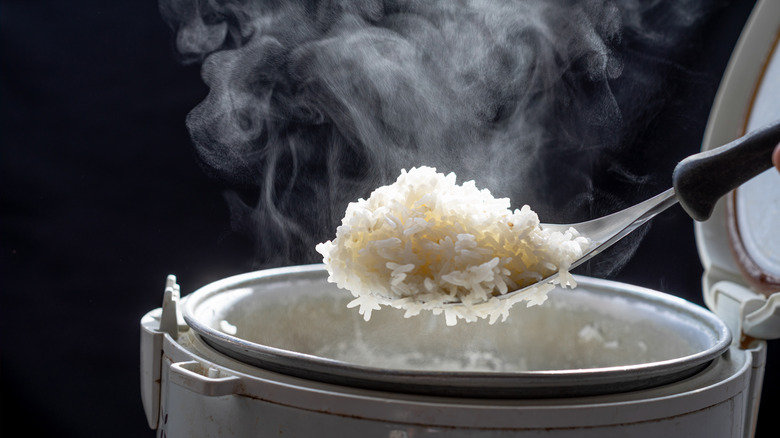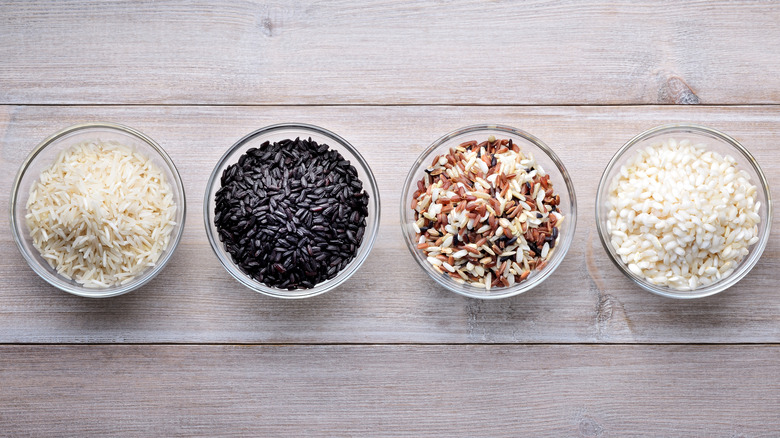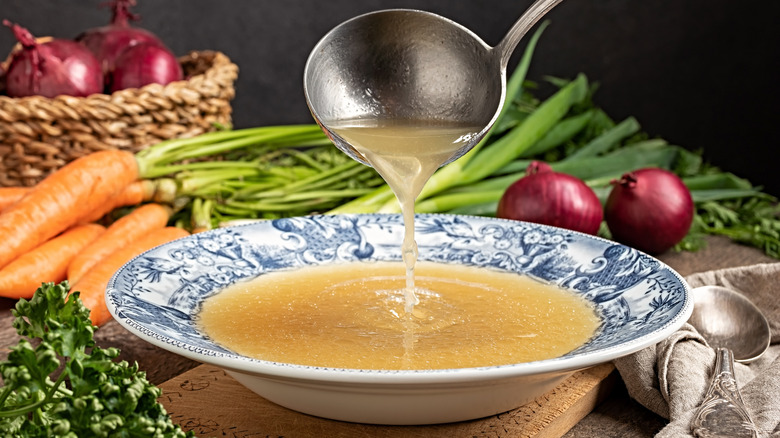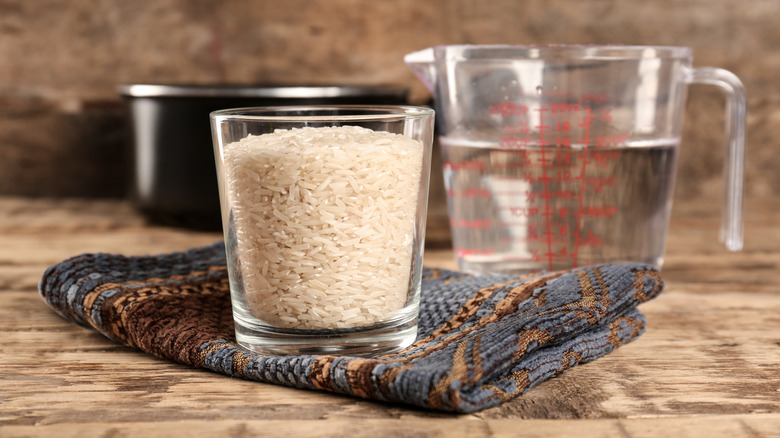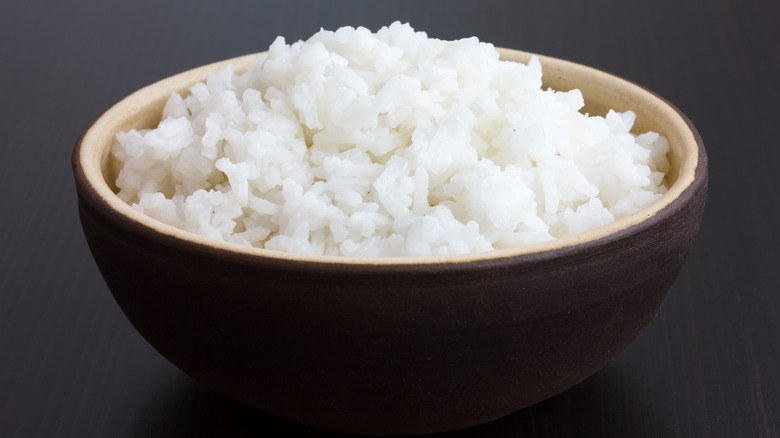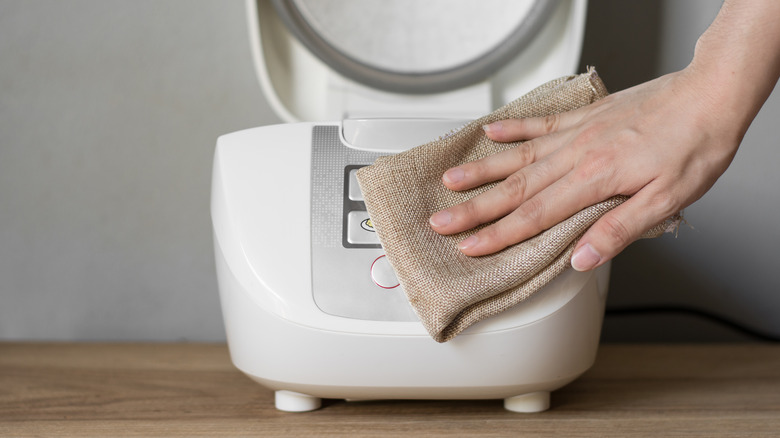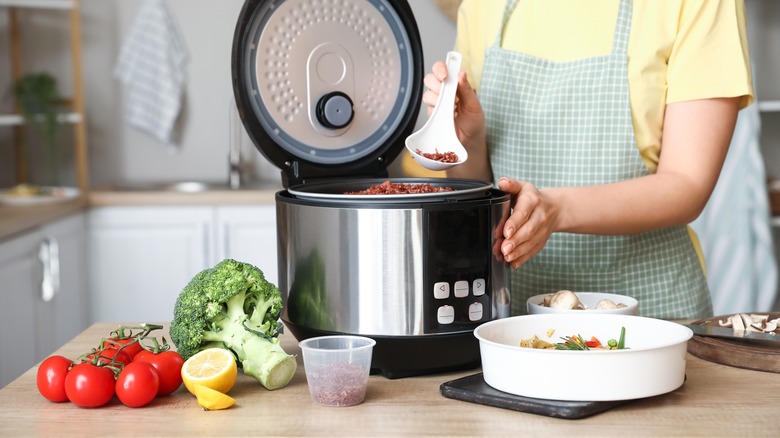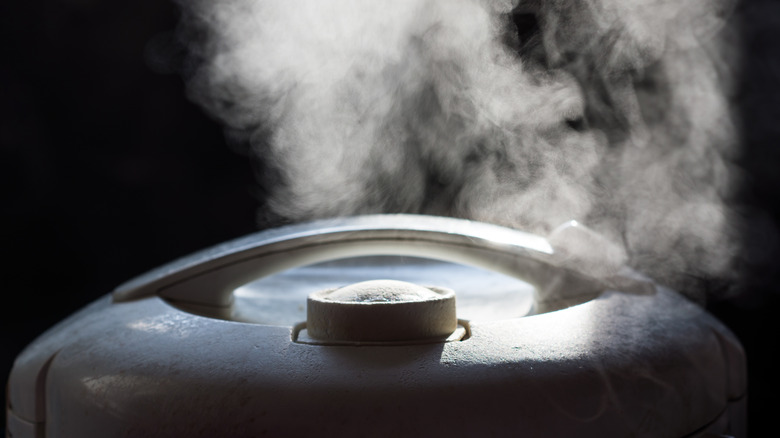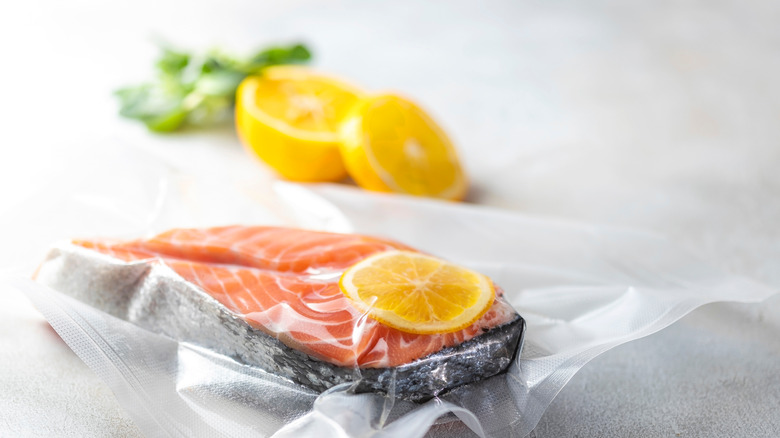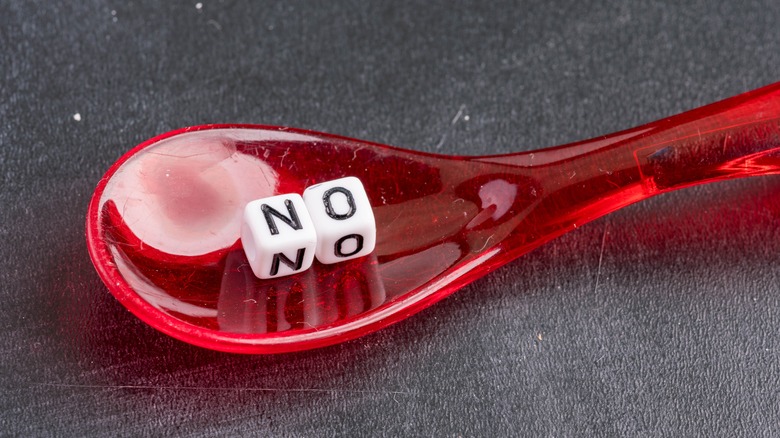10 Tips You Need When Using A Rice Cooker
In 1955, Toshiba dropped the first-ever automatic electric rice cooker onto the store shelves of Japan. Since then, this humble household item has gone on to sell like gangbusters. In 2018, the rice cooker industry was valued at a whopping $3.2 billion. Moreover, by 2026, this industry is expected to rise in value, becoming an estimated $5.5 billion total (via Business Wire).
The fact that rice cookers are super-duper popular shouldn't be surprising. They're brilliant, turning a tedious task into a walk in the park. However, just because these tools are beloved doesn't mean that they're entirely intuitive. There are a bunch of tips and tricks you should know about using a rice cooker if you want to get the most out of these machines.
So, what are the best rice cooker hacks that are out there? What can a person do to get the most out of one of these bad boys? Well, if these rhetorical questions resonated throughout your body and spirit, you've come to the right place because we're about to deep dive into the sagest rice cooker advice that's ever existed.
Different types of rice requires different cooking times
According to USA Rice, more than 120,000 types of rice exist. Furthermore, some of these grains take longer to cook than others, which means that many rice types will have different cook times inside the rice cooker. So, should you memorize how long it takes to cook all 120,000 varieties of rice? Absolutely not. That being said, it wouldn't hurt to learn how long you should cook the most popular types of rice in your rice cooker.
In a Black + Decker rice cooker, 1 cup of white rice will take 16 to 19 minutes, while 1 cup of brown rice will take 59 to 60 minutes. Wild rice takes even longer to get prepped in this machine, with a single cup of the stuff taking 73 to 76 minutes to cook (via Prudent Reviews).
However, the Black + Decker cooking times aren't universal. For instance, the Aroma Housewares rice cooker takes 26 to 35 minutes to cook a cup of white rice and 50 to 60 minutes to cook a cup of brown rice. Therefore, it's always worth consulting your rice cooker's manual instead of assuming you know how it'll handle one of the world's 120,000 types of rice grains.
You can cook your rice in stock instead of water
Some days, your palate might want your rice to have a little more flavor and pizzazz. On such an occasion, you should cook your rice in some stock instead of water. According to food blogger Jill Nystul, adding a bit of chicken stock into your rice cooker will give your grains a delightful savory flavor. In fact, Nystul believes that doing this makes the best-tasting rice on the planet.
However, if chicken stock isn't your cup of tea, beef stock or veggie stock will work just as well in your rice cooker. Furthermore, it doesn't matter if you use stock from a packet or from scratch because both of these flavorful ingredients will successfully absorb into the cooking rice. So, now that this hack is at the forefront of your noggin, it might be time to make this amazing dish.
Know the best water ratio for each type of rice
Not only do different types of rice require different cook times, but they also require varying amounts of water. This is because if you cook your rice in too much water, it'll become criminally goopy. Moreover, if you don't use enough water, your dish will become drier than the Saharan desert.
So, with all that in mind, how much water should you use when making a cup of long-grain white rice? Well, according to The Kitchen Community, you'll need 2 cups of water for every cup of long-grain white rice you're cooking. However, if you're making a cup worth of short-grain white rice, you'll only need 1 ¼ cup worth of water. If you're putting some wild rice in your rice cooker, then you should use 2 cups of water for every cup of rice, the same ratio as long-grain white rice.
Rest cooked rice for fluffy texture
A lot of A+ dishes require fluffy rice, making it a fantastic side dish with chicken curry, steamed veggies, and even just a splash of soy sauce. Therefore, if you have a rice cooker, being able to transform your little grains into fluffy clouds is a must.
Now, there are plenty of different ways to get your rice extra fluffed, but the following method is definitely the easiest. All you have to do is leave your rice in the rice cooker for an extra 10 minutes once it's finished cooking. Yup, it's really that simple. Doing so will result in just a pinch of extra moisture getting into each grain of rice, making them plump but not mushy. After waiting for 10, use a rice paddle to jumble up the layers before serving (via Good Housekeeping). Once you've completed these tasks, enjoy your incredibly fluffy rice — you've earned it.
Know how to clean your rice cooker
Here's a fun fact: You can't put a rice cooker into the dishwasher. Well, you could, but it would be a miracle if it worked afterward. If you want your rice cooker to be spick and span, then you have to know how to take care of it the right way.
So, how does one clean up a dirty rice cooker? Well, according to My Asian Cooking, it takes warm soapy water and a bit of patience. You have to let the rice cooker's inner pot sit in warm water for around 20 minutes. Afterward, take a nonmetal spatula and scrape off any unwanted grains. It's important that you don't use a scouring pad, as such an instrument can scratch or damage the rice cooker's inner pot.
To clean a rice cooker's lid, find out if it's detachable or not. If your rice cooker's lid detaches, wash it in the same soapy water. But if it doesn't have a detachable lid, dip a sponge in some warm soapy water before using it to wipe down your lid thoroughly. Once you've completed this step, wipe down the lid with a wet washcloth to get off any leftover soap.
You can cook more than rice in a rice cooker
Since the invention of the rice cooker, these machines have gone to transcend their original limitations. For instance, some modern rice cookers are also designed to cook dishes like oatmeal. However, you can push the capabilities of your rice cooker even further. As cookbook author Michelle Tchea told ABC, you can use a rice cooker to create a dish that consists of salmon, some veggies, a bit of miso, broth, and rice wine.
Tchea also recommended that you use a rice cooker to make cinnamon apples. "Cut up all the apples into large chunks and put in any spices that you want, like cinnamon, allspice, star anise, a bit of sugar, a splash of port wine," said Tchea. Additionally, Tchea expressed that if you make an oat crumble, you'll have created an apple crumble that doesn't require an oven or much washing up.
But is this all the humble rice cooker can create? Nope! Just One Cookbook expressed that you can use a rice cooker to make amazake, a warm, sweet Japanese sake. And Tiger Corporation suggested that their rice cookers can be used to create nonalcoholic mulled wine. This just goes to demonstrate that when it comes to making stuff in a rice cooker, the possibilities are pretty darn extensive.
You can reheat your leftovers in a rice cooker
There's no denying it — most microwaves are kind of trash. They'll make some of your food too hot while other parts won't be hot enough. They'll make your bowls scorching to the touch and cause food to bubble and splatter everywhere. Face it — there's got to be a better way that humans can reheat their meals.
Enter the humble rice cooker. Yup, not only can these bad boys cook your dinner, but they can also revive your leftovers (via Readers Digest). Moreover, they do this job better than any old microwave can. This is because a rice cooker will keep each part of your dish consistently warm. Better yet, you don't have to fiddle around with getting your fingers burnt and blistered by a burning hot bowl.
Rice cookers are the most successful at reheating meals that benefit from rehydrating. For instance, if you put a pasta dish in your rice cooker and a splash of water, the resulting steam will moisten your dish to make it plump and tasty.
Figure out if your rice cooker uses fuzzy logic
The description fuzzy logic doesn't sound very appealing. After all, if someone were to say that you were using fuzzy logic, you'd probably assume they were insulting your problem-solving skills. But luckily, when we're talking about rice cookers, this phrase isn't derogatory. Moreover, if your rice cooker were to have fuzzy logic, that would be a top-notch thing.
So, what does a fuzzy logic rice cooker do? The answer is that it basically does everything. Fuzzy logic rice cookers use advanced technology to sense how much water you're using, how much rice there is, and how long your grains need to be cooked. It's basically an AI chef that'll cook you perfectly scrumptious rice every single time (via CNET).
Ergo, if you're about to purchase a rice cooker, it might be worth buying a fuzzy logic one. Yes, it's usually more expensive than a basic model, but if you're cooking rice multiple times a week, such a machine could pay for itself.
You can transform a rice cooker into a sous vide
If you have no idea what sous vide is, don't beat yourself up. Basically, it's a fancy French cooking technique that's typically reserved for posh chefs and five-star restaurants. Sous vide is where a person vacuum seals ingredients in a bag before cooking them in water at a very precise temperature. This technique can produce pieces of meat that are unbelievably scrummy and succulent (via ANOVA).
Purchasing professional sous vide equipment can get pretty pricey. However, as one person on Reddit discovered, you can use any old rice cooker to sous vide pieces of chicken, pork, and beef to make them incredibly tender. All you have to do is put your ingredient in a zip-lock bag, get the air out of them, and place them in a rice cooker that's been filled with hot water. This is followed by using a digital thermometer to determine if your cuts of meat are cooking at the right temperature and for the right number of minutes. Afterward, remove your ingredient from your bag and enjoy ballin' on a budget.
Don't interrupt the rice during cooking
When you're whipping up some rice, you might be tempted to jump into the mix. You may have impulses to open the rice cooker's lid, have a cheeky inspection, and maybe even give your grains a little stir. After all, cooking should be an active activity, right? Well, when it comes to using a rice cooker, the last thing you should do is start fiddling.
But what makes opening a lid and stirring your rice such an egregious act? Fortunately, Insider published an article with some answers. They stated that opening the lid would lower the rice's temperature and make it mushy. And nobody wants to eat lukewarm glops of miserable rice.
So, if you're a busybody in the kitchen, resist the urge to open up your rice cooker. Doing so might require all of your willpower. Nevertheless, your palette will definitely thank you for it later.
